

MY OCCULT CIRCLE. Dedication Of Per Ma'at Kemetic Temple. The 42 Laws of Maat. Maat The Egyptian Goddess. Areas of Influence: Maat the Egyptian Goddess stood for truth and justice.
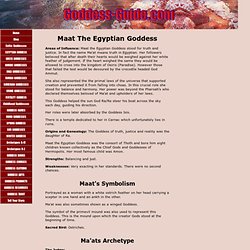
In fact the name Ma'at means truth in Egyptian. Her followers believed that after death their hearts would be weighed against her white feather of judgement. If the heart weighed the same they would be allowed to cross into the kingdom of Osiris (Paradise). However those that failed the test would be devoured by the crocodile headed God Ammut. She also represented the the primal laws of the universe that supported creation and prevented it from falling into choas. This Goddess helped the sun God Ra/Re steer his boat across the sky each day, guiding his direction. Her roles were later absorbed by the Goddess Isis. There is a temple dedicated to her in Carnac which unfortunately lies in ruins. Maat (Egyptian Goddess) Maat.
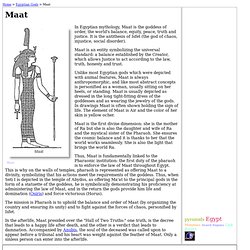
In Egyptian mythology, Maat is the goddess of order, the world's balance, equity, peace, truth and justice. It is the antithesis of Isfet (the god of chaos, injustice, social disorder). Maat is an entity symbolizing the universal standard: a balance established by the Creator, which allows Justice to act according to the law, truth, honesty and trust. Unlike most Egyptian gods which were depicted with animal features, Maat is always anthropomorphic, and like most abstract concepts is personified as a woman, usually sitting on her heels, or standing.
MAAT: the Goddess from Egyptian mythology. Despite her permanent head decoration of an ostrich feather, she is far from a feather brain.
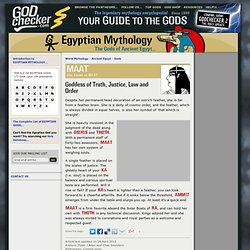
She is a deity of cosmic order, and the feather, which is always divided in equal halves, is also her symbol of 'that which is straight'. She is heavily involved in the judgment of the dead along with OSIRIS and THOTH. With a permanent staff of forty-two assessors, MAAT has her own system of weighing souls. A single feather is placed on the scales of justice. The ghostly heart of your KA (i.e. soul) is placed on the balance and various spiritual tests are performed. MAAT is a firm favorite aboard the Solar Boats of RA, and can hold her own with THOTH in any technical discussion. Share this page: Article last updated on 29 April 2013 Authors: Peter J Allen and Chas Saunders References: Coming soon. COPYRIGHT © 1999-2013. Godchecker's article on Maat is based on material from ancient texts, original references and our own research.
Suggested further reading... Join the Godchecker mailing list. Maat Goddess of Truth and Justice ~ Ancient Egypt Facts. Ancient Egyptian Gods. Pharaohs also practiced this god’s concept of order during their reign.
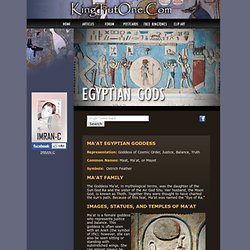
Pharaohs were expected to practice Ma’at, which meant it was their job to keep their nation in a state of order. This meant building temples, making offerings to the gods, keeping enemies at bay, and making honest decisions. Anything else was considered chaos and disorder. The people of Egypt believed that through Ma’at, the pharaoh kept Egypt stable and orderly. To some pharaohs, Ma’at was so intertwined into their kingdoms that some pharaohs changed their staffs’ names to accommodate this god. Ma'at. The concept of Ma'at brings together several completely disassociated dimensions in Egyptian imaginary.

We are not going to separate them for didactic reasons. Ma'at is at the heart of understanding Egyptian civilisation in its entirety, and is the foundation of its longevity. It is bound to and confused with ethics (including justice and truth), with universal order (cosmic order, social order and political order) and with social integration based on communication and confidence. Ma'at. Ma'at, Goddess of Truth, Balance, Order. Ma'at, Symbol of Order Ma'at, Goddess of Truth, Balance, Order... Ma'at, unlike Hathor and Nephthys, seemed to be more of a concept than an actual goddess. Her name, literally, meant 'truth' in Egyptian. She was truth, order, balance and justice personified. She was harmony, she was what was right, she was what things should be. It was thought that if Ma'at didn't exist, the universe would become chaos, once again!
For the Egyptian believed that the universe was above everything else an ordered and rational place. Maat. The earliest surviving records indicating Maat is the norm for nature and society, in this world and the next, were recorded during the Old Kingdom, the earliest substantial surviving examples being found in the Pyramid Texts of Unas (ca. 2375 BCE and 2345 BCE).[2] Later, as a goddess in other traditions of the Egyptian pantheon, where most goddesses were paired with a male aspect, her masculine counterpart was Thoth and their attributes are the same.
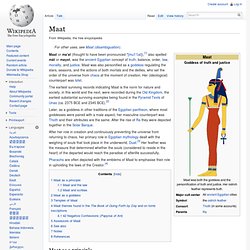
After the rise of Ra they were depicted together in the Solar Barque. After her role in creation and continuously preventing the universe from returning to chaos, her primary role in Egyptian mythology dealt with the weighing of souls that took place in the underworld, Duat.[3] Her feather was the measure that determined whether the souls (considered to reside in the heart) of the departed would reach the paradise of afterlife successfully. Maat as a principle[edit] Winged Maat.